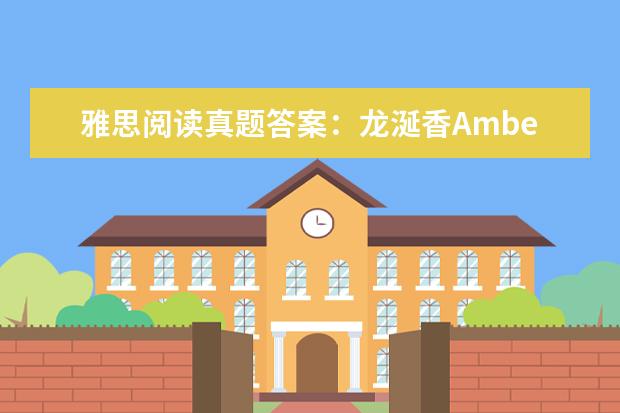当前城市:淄博[切换]
- 手机雅思无忧

扫码登录
雅思阅读熟词多义题解析 8月1日雅思阅读考试真题答案 雅思阅读真题答案:龙涎香Ambergris相关内容,小编在这里做了整理,希望能对大家有所帮助,关于雅思阅读熟词多义题解析 8月1日雅思阅读考试真题答案 雅思阅读真题答案:龙涎香Ambergris信息,一起来了解一下吧!

英语中纯粹的单义词很少,绝大多数词都是多义词,即一个词项有两个或两个以上的意义。在雅思阅读中,有很多词汇看似很简单,很熟悉,殊不知他有多个意思。把小伙伴们都迷得晕头转向的。今天我来为大家收集整理了雅思阅读熟词多义题解析,希望小伙伴们在雅思考试时能提高警惕,不再犯迷糊!
以下主要就雅思阅读剑桥真题部分的一些存在熟词多义的题目进行解析:
1.drive
C4T1P1:
In other words, they gave no indication of an appreciation of either the range of ways in which rainforests are important or the complex social, economic and political factors which drive the activities which are destroying the rainforests.
这是一个复杂的长难句,一共出现了三处定语从句,一处ways in which, 一处factors which,一处activities which。
drive的主语为连接代词which代指的先行词factors,提取之后变为factors drive the activities, 这里如果将这里作为动词的drive 翻译成驾驶,句子是完成不通顺的,我们从后一处的定语从句中得知,activities指的是破坏雨林的行为,也就是前面的社会经济和政治因素drive了一些破坏雨林的行为,也就是说,这里的drive是导致,迫使的意思。
C6T1P2
选项型SUMMARY
Q24: Manufacturers of computers, for instance, are able to import 24................. from overseas, rather than having to rely on a local supplier.
文章E段 To see how this influences trade, consider the business of making disk drives for computers. Most of the world's disk-drive manufacturing is concentrated in South-east Asia. This is possible only because disk drives, while valuable, are *all and light and so cost little to ship. Computer manufacturers in Japan or Texas will not face hugely bigger freight bills if they import drives from Singapore rather than purchasing them on the domestic market.
通过manufacturers of computers定位到E段。阅读后我们可以知道电脑*商集中在东南亚*和进口disk drives而不是本国市场。如果同学对电脑知识比较了解的话,对于drive在这里的理解应该问题不大。根据一定的语法知识我们看得出这里的disk drives和disk-drive是名词用法,可通过drive的基本含义“驾驶”进一步引申理解,“驾驶磁盘”过渡为“让磁盘启动”,正确的理解含义为:磁盘驱动器。对应到题目提供的选项“B. components”
2.subject
我们知道它由“科目”的意思,词汇稍好的同学还会知道它还有“主语”和“主题”的含义。我们来看下面一题:
C5T1P2
单选题 Q20 The teacher-subjects were told that they were testing whether
A a 450-volt shock was dangerous.
B punishment helps learning.
C the pupils were honest.
D they were suited to teaching.
文章A段 Specifically, Milgram told each volunteer 'teacher-subject' that the experiment was in the noble cause of education, and was designed to test whether or not punishing pupils for their mistakes would have a positive effect on the pupils' ability to learn.
文章这里的'teacher-subject'打了引号,也就是说即便同学你不认识,把它当作一个特殊词符号,不理解不影响做题。不过明显的是,把“科目”“主语”“主题”放这里,都不好理解。在雅思阅读学术实验类的文章中,subject是个高频词汇,作为“实验对象”的含义来使用, 有时会同义替换为volunteer或participant。
C8T1P3
表格填空Q38 The results were then subjected to a 38…………………….
文章:In 1987, results from hundreds of autoganzfeld tests were studied by Honorton in a 'meta-*ysis', a statistical technique for finding the overall results from a set of studies.
通过冠词a我们可以知道此空填名词单数,并且从表格纵轴同行的特殊定位词in 1987,我们找到了定位句。但是定位句中存在冠词a的三处,到底三处后的单词填哪个呢。单词不会,语法来凑,通过题目和文章的主干结构的一致性:A be subjected to B和A be studied By B in C, 由于Honorton是人名且不符合填词规定,顺理成章的'meta-*ysis'成为我们的选填对象。那subject to到底什么意思呢,通过文章,我们可以知道大概是被研究的意思,查了字典我们就了解,正确含义为“受…支配”。
类似的用法单词还有:
1. state n. (美国的)州,状态,*,adj. 国家的,国立的 v.陈述,说明
C8T4P1 判断题Q8 Private schools in Japan are more modern and spacious than state-run lower secondary schools. State-run adj国立的
C7T4P1 第5段 There was a huge initial force- five times larger than the steady state force, Gharib says. State n.状态
2. coin n. 硬币, v. 创造,铸造
C7T1P1 E段 The American zoologist Donald Griffin, who was largely responsible for the discovery of sonar in bats, coined the term 'echolocation' to cover both sonar and radar, whether used by animals or by human instruments. Coin v 创造(first used)
3. spoke v. speak过去式,n 车轮的辐条(C4T1P3)
4. tuitionn. 学费,课程,讲授,教学(C4T1P1)
5. complaint n. 抱怨,*,疾病(C4T2P2)
6. Interest v. 是感兴趣n. 兴趣,利益,利息(C4T3P1)
7. leaves v. leave的动词三单形式 n.叶子(Pl)(C8T4P3)
8. press v. 按压,n. 印刷,新闻工作者,新闻(C5T1P3/C5T4P2)
(pressing adj. 迫切的,急切的 C7T1P2)
希望以上内容能对大家有所帮助!我预祝大家在雅思阅读考试中能够取得理想的成绩!更多信息敬请关注雅思频道!
8月1号进行了八月初的第一场雅思的考试,相信大家对真题以及答案会非常的感兴趣、今天就由的我为大家介绍2020年8月1日雅思阅读考试真题答案。
一、考题解析
P1 土地沙漠化
P2 澳大利亚的鹦鹉
P3 多重任务
二、名师点评
1.8月份首场考试的难度总体中等,有出现比较多的配对题,没有出现Heading题,其余主要以常规的填空,判断和选择题为主。文章的话题和题型搭配也是在剑桥真题中都有迹可循,所以备考重心依然还是剑桥官方真题。
2. 整体分析:涉及环境类(P1)、动物类(P2)、社科类(P3)。
本次考试的P2和P3均为旧题。P2是动物类的话题,题型组合为:段落细节配对+单选+summary填空,难度中等。题型上也延续19年的出题特点,出现配对题,考察定位速度和准确度。P3也出现了段落细节配对,主要是段落细节配对+单选+判断。三种题型难度中等,但是文章理解起来略有难度。
3. 部分答案及参考文章:
Passage 1:土地沙漠化
题型及答案待确认
Passage 2:澳大利亚的鹦鹉
题型:段落细节配对+单选+Summary填空
技巧分析:由于段落细节配对是完全乱序出题,在定位时需要先做后面的单选题及填空题,最大化利用已读信息来确定答案,尽量避免重复阅读,以保证充分的做题时间。
文章内容及题目参考:
A 概况,关于一个大的生物种类
B 一些物种消失的原因,题干关键词:an example of one bird species extinct
C 一种鹦鹉不能自己存活,以捕食另一种鸟为生,吃该鸟类的蛋。题干关键词:two species competed at the expense of oneanother
D 吸引鹦鹉的原因以及鹦鹉嘴的特点。题干关键词:*ysis of reasons as Australian landscapeattract parrots
E 植物是如何适应鹦鹉。题干关键词:plants attract birds which make the animal adaptto the environment
F 南半球对英语的影响
G 两种鹦鹉从环境改变中获益并存活下来。题干关键词:two species of parrots benefit fromm theenvironment change
H 外来物种及本地鹦鹉
I 鸟类栖息地被破坏以及人类采取的措施
J 作者对于鹦鹉问题的态度
单选题:
why parrots in the whole world are lineal descendants of
选项关键词:continent split from Africa
the writer thinks parrots species beak is for
选项关键词:adjust to their suitable diet
which one is not mentioned
选项关键词:should be frequently maintained
填空题:分布在文章的前两段
one-sixth
16th century
mapmaker
John Gould
Passage 3:多重任务
题型:段落细节配对+单选+判断
参考答案及文章
28 F
29I
30C
31B
32G
33C
34B
35A
36YES
37YES
38NO
39NOT GIVEN
40NO
Passage3: multitasking
Multitasking Debate—Can you do them at the same time?
Talking on the phone while driving isn't the only situationwhere we're worse at multitasking than we might like to think we are. Newstudies have identified a bottleneck in our brains that some say means we arefundamentally incapable of true multitasking. If experimental findings reflectreal-world performance, people who think they are multitasking are probablyjust underperforming in all-or at best, all but one -of their parallelpursuits. Practice might improve your performance, but you will never be asgood as when focusing on one task at a time.
The problem, according to René Marois, a psychologist atVanderbilt University in Nashville, Tennessee, is that there's a sticking pointin the brain. To demonstrate this, Marois devised an experiment to locate nteers watch a screen and when a particular image appears, a red circle,say, they have to press a key with their index finger. Different colouredcircles require presses from different fingers. Typical response time is about half a second, and thevolunteers quickly reach their peak performance. Then they learn to listen todifferent recordings and respond by making a specific sound. For instance, whenthey hear a bird chirp, they have to say "ba"; an electronic soundshould elicit a "ko", and so on. Again, no problem. A normal personcan do that in about half a second, with almost no effort. The trouble comeswhen Marois shows the volunteers an image, then almost immediately plays them asound. Now they're flummoxed. "If you show an image and play a sound atthe same time, one task is postponed," he says. In fact,if the second taskis introduced within the half-second or so it takes to process and react to thefirst, it will simply be delayed until the first one is done. The largestdual-task delays occur when the two tasks are presented simultaneously; delaysprogressively shorten as the interval between presenting the tasks lengthens(See Diagram).
There are at least three points where we seem to getstuck, says Marois. The first is in simply identifying what we're looking can take a few tenths of a second, during which time we are not able tosee and recognise a second item. This limitation is known as the"attentional blink": experiments have shown that if you're watchingout for a particular event and a second one shows up unexpectedly any timewithin this crucial window of concentration, it may register in your visualcortex but you will be unable to act upon it. Interestingly, if you don'texpect the first event, you have no trouble responding to the second. Whatexactly causes the attentional blink is still a matter for debate.
A second limitation is in our short-term visual 's estimated that we can keep track of about four items at a time, fewer ifthey are complex. This capacity shortage is thought to explain, in part, our astonishinginability to detect even huge changes in scenes that are otherwise identical,so-called "change blindness". Show people pairs of near-identicalphotos -say, aircraft engines in one picture have disappeared in the other -andthey will fail to spot the differences (if you don't believe it, check out theclips at /~rensink/flicker/download). Here again, though, thereis disagreement about what the essential limiting factor really is. Does itcome down to a dearth of storage capacity, or is it about how much attention aviewer is paying?
A third limitation is that choosing a response to astimulus -braking when you see a child in the road, for instance,or replyingwhen your mother tells you over the phone that she's thinking of leaving yourdad -also takes brainpower. Selecting a response to one of these things willdelay by some tenths of a second your ability to respond to the other. This iscalled the "response selection bottleneck" theory, first proposed in1952.
Last December, Marois and his colleagues published apaper arguing that this bottleneck is in fact created in two different areas ofthe brain: one in the posterior lateral prefrontal cortex and another in thesuperior medial frontal cortex (Neuron, vol 52, p 1109). They found this byscanning people's brains with functional MRI while the subjects struggled tochoose among eight possible responses to each of two closely timed tasks. Theydiscovered that these brain areas are not tied to any particular sense but aregenerally involved in selecting responses, and they seemed to queue theseresponses when presented with multiple tasks concurrently.
Bottleneck? What bottleneck?
But David Meyer, a psychologist at the University ofMichigan, Ann Arbor, doesn't buy the bottleneck idea. He thinks dual-taskinterference is just evidence of a strategy used by the brain to prioritisemultiple activities. Meyer is known as something of an optimist by his has written papers with titles like "Virtually perfect time-sharing indual-task performance: Uncorking the central cognitive bottleneck"(Psychological Science, vol 12, p101). His experiments have shown that withenough practice -at least 2000 tries -some people can execute two taskssimultaneously as competently as if they were doing them one after the suggests that there is a central cognitive processor that coordinates allthis and, what's more, he thinks it uses discretion: sometimes it chooses todelay one task while completing another.
Even with practice, not all people manage to achieve thisharmonious time-share, however. Meyer argues that individual differences comedown to variations in the character of the processor -some brains are just more"cautious", some more "daring". And despite urban legend,there are no noticeable
differences between men and women. So, according to him,it's not a central bottleneck that causes dual-task interference, but rather"adaptive executive control", which "schedules task processesappropriately to obey instructions about their relative priorities and serialorder".
Marois agrees that practice can sometimes eraseinterference effects. He has found that with just 1 hour of practice each dayfor two weeks, volunteers show a huge improvement at managing both his tasks atonce. Where he disagrees with Meyer is in what the brain is doing to achievethis. Marois speculates that practice might give us the chance to find lesscongested circuits to execute a task -rather like finding trusty back streetsto avoid heavy traffic on main roads -effectively making our response to thetask subconscious. After all, there are plenty of examples of subconsciou*ultitasking that most of us routinely manage: walking and talking, eating andreading, watching TV and folding the laundry.
But while some dual tasks benefit from practice, otherssimply do not. "Certain kinds of tasks are really hard to do two atonce," says Pierre Jolicoeur at the University of Montreal, Canada, whoalso studies multitasking. Dual tasks involving a visual stimulus andskeletal-motor response (which he dubs "in the eye and out the hand")and an auditory stimulus with a verbal response ("in the ear and out themouth") do seem to be amenable to practice, he says. Jolicoeur has foundthat with enough training such tasks can be performed as well together asapart. He speculates that the brain connections that they use may be somehowspecial, because we learn to speak by hearing and learn to move by looking. Butpair visual input with a verbal response, or sound to motor, and there's nodramatic improvement. "It looks like no amount of practice will allow youto combine these," he says.
For research purposes, these experiments have to be keptsimple. Real-world multitasking poses much greater challenges. Even the upbeatMeyer is sceptical about how a lot of us live our lives. Instant-messaging andtrying to do your homework? "It can't be done," he says. Conducting ajob interview while answering emails? "There's no way you wind up being asgood." Needless to say, there appear to be no researchers in the area ofmultitasking who believe that you can safely drive a car and carry on a phoneconversation. In fact, last year David Strayer at the University of Utah inSalt Lake City reported that people using cellphones drive no better thandrunks (Human Factors, vol 48, p 381). In another study, Strayer found thatusing a hands-free kit did not improve a driver's response time. He concludedthat what distracts a driver so badly is the very act of talking to someone whoisn't present in the car and therefore is unaware of the hazards facing thedriver.
“No researchers believe it's safe to drive a car andcarry on a phone conversation”
It probably comes as no surprise that, generallyspeaking, we get worse at multitasking as we age. According to Art Kramer atthe University of Illinois at Urbana-Champaign, who studies how ageing affectsour cognitive abilities, we peak in our 20s. Though the decline is slow throughour 30s and on into our 50s, it is there; and after 55, it becomes moreprecipitous. In one study, he and his colleagues had both young and oldparticipants do a simulated driving task while carrying on a conversation. Hefound that while young drivers tended to miss background changes, older driversfailed to notice things that were highly relevant. Likewise, older subjects hadmore trouble paying attention to the more important parts of a scene than youngdrivers.
It's not all bad news for over-55s, though. Kramer alsofound that older people can benefit from practice. Not only did they learn toperform better, brain scans showed that underlying that improvement was achange in the way their brains become active.
Whileit's clear that practice can often make a difference, especially as we age, thebasic facts remain sobering. "We have this impression of an almightycomplex brain," says Marois, "and yet we have very humbling andcrippling limits." For most of our history, we probably never needed to domore than one thing at a time, he says, and so we haven't evolved to be ableto. Perhaps we will in future, though. We might yet look back one day on peoplelike Debbie and Alun as ancestors of a new breed of true multitaskers.
为了帮助大家备考雅思的阅读,参考更多真题,下面我给大家带来雅思阅读真题答案:龙涎香 Ambergris,望喜欢!
雅思阅读真题答案:龙涎香 Ambergris
文章 标题 Ambergris 龙涎香 文章大意 关于ambergris龙涎香和amber琥珀
第一段说 ambergris这个东西很久以前就有了,然后说ambergris的用途有 for medicine, spice,用来*perfume 什么的等等(有题,matching) 然后说但是人们不知道它是从哪里来的,再就是说在古代it worth in weight in gold,当然是贵了。
第二段说 以前人们一直把ambergris和amber当作一种东西。但是有个叫Dick的作者 写了一本书 讲了这两个东西的区别(有题,matching)说ambergris 通常发现在海面或者shore,但是仍然不知道是从哪里来的。 Amber是一种什么东西,与松树pine有关, 然后说了amber的一些特性 hard,transparent, 等等,用来做装饰品, 头饰什么的, 同样 very costly。(有题,matching)
第三段说ambergris是与sperm whale的intestine肠子里的消化digest 某种东西有关。以为intestine会有题,结果没有,提到了马可波罗,好像与这个发现有关(没题,当笑话好了)
第四段就是具体describe ambergris的产生过程了。(summary 题)大意是,sperm whale吃一种东西 叫 beaks of squalid, 肠子就有助消化,但是不能完全消化,就转化成了另一种东西,应该是体内的垃圾。这种垃圾是soft的,会被sperm whale 呕吐出来 be vomited up。 然后这种东西遇到空气就会变硬 harden, 于是就形成了 ambergris了,也解释了为什么ambergris总在海面和shore被发现。
第五段 说人们为了获得ambergris而捕杀sperm whale 导致了濒临灭绝。给了一个数据 说in 20th century, 90% ambergris was made in the processing of killing sperm whale。(有题, TFNG)ambergris was still the most expensive product in the whole body of sperm whale,大意是这样的。 于是人们就开始采取 措施 保护sperm whale, 在工业生产中采用了很多ambergris的替代品,例如香水*业中就用了某种东西,代替了ambergris。
第六段 说 sperm whale的数量会有recover的那么一天,没题。 题目类型 Matching
Summary填空
T/F/NG 参考答案 Matching
A only ambergris
B only amber
C both
D neither
·very expensive C
·use in medicine A
·use as currency D
·refers to in a Book written by Dick _x C
·could be seen through B Summary填空
ambergris的形成步骤龙涎香是抹香鲸的呼吸道分泌物
·sperm whale 吃下去 beaks of squalid,
·_x be vomited up,
·hardens when exposure on air T/F/NG
·20th century most ambergris was made in the processing of killing of sperm whale。 T
·Ambergris’s cost increased recently。 NG
·ambergris still remains in the perfume making。 F
·关于保护鲸鱼的 F
两招教你突破雅思阅读判断题三大难点
但凡接触过雅思真题或曾经亲历雅思考场的考生大多对TRUE/FALSE/NOT GIVEN (另一种写法为YES/NO/NOT GIVEN)的题型颇有印象,原因有二:
一是此题型在考场上出现频率极高,仅以2021年为例,全年48场雅思考试场场都有此题型的身影;
二是此题型虽然备选项只有三个,答题命中率在理论上比四选一的单选题还高,却颇不容易全盘做对。
下面笔者将带领读者一起来仔细认识与分析雅思阅读判定题的概念、套路、难点和解决之道。
雅思判断题的定义
理解判断题的第一步是理解TRUE/FALSE/NOT GIVEN的定义,逐一分析如下:
TRUE (YES)的定义为the statement agrees with the information/the views (claims) of the writer,即“此说法与原文信息/作者的观点或主张相符”。这里的重点信息在于agree with的概念,此选项并非要求题干与原文的内容一模一样,而只要符合原文信息即可。
举个例子说明,原文 句子 说“这个女生长得很漂亮”,那么题干说“这个女生长得很好看”或“这小姑娘长相真是还可以”都是与原文信息相符,此时考生要选TRUE (YES)。
FALSE (NO)的定义为the statement contradicts the information,即“如果此说法与原文信息相矛盾和抵触”。这里的重点信息在于contradict一词:contra是“相反”“相违背”的意思,dict则是“陈述”“说明”的意思。也就是说,应选FALSE的题干与原文信息是相矛盾、相违背、相抵触的,原文中给出的已知信息可以直接或经过合理推理否定掉题干的内容。
比如,原文说“这个女生长得很漂亮”,那题干说“这姑娘长得真丑”就是错误的,或者题干说“这位小娘子貌似无颜”,也是错误的。
NOT GIVEN的定义为there is no information on this/it is impossible to say what the writer thinks about this,即“此说法在原文中找不到”或“没法知道作者对此是怎么看的”。许多考生都将此视为最麻烦的一个选项,因为如果不能把整篇文章都看完并且看懂,每个NOT GIVEN的选项都是在惴惴不安的心情中写下的。
NOT GIVEN的情况其实可以分为以下两种:
① 原文中完全没有提及题干所说的相关内容,不过这种完全无中生有的题目比较罕见;
② 原文中提到的相关信息与题干内容不属于同一个范围或性质。
比如题干说“这个女生长得很好看”,而原文中提到的与“此女生”有关的内容是“这个女生是个善良的好孩子,这种情况下,长相和个性虽然都是在描述这个女生,但两者既不一致也不矛盾,此时考生应选NOT GIVEN。
雅思判定题出题套路
判断题的逻辑其实不难理解,但许多考生依然烦恼:看定义貌似懂了,一到做题的时候还是纠结不已。这跟考生的单词量、语法基础、长难句分析能力和思维习惯等方面都有关系。不过 总结 起来,每个选项的出题还是有一定套路的。
以下笔者来一一详述。
1. TRUE (YES)的出题套路
① 直接说对
“直接说对”指的是题干的意思与原文定位到的句子只是简单的同义替换,考生能直接判断题干所说与原文信息相符。
这样的题目其实是在考查考生的单词量大小,因为题干会使用不同的词汇对原文进行同义替换。
比如题干说long-term medical complaints,原文说chronic illnesses,考生就不但要认识long-term与chronic是同义替换关系,而且要明白medical与complaint组合在一起并不是“医疗投诉、医疗纠纷”这类意思,而是作为一个词组表示“疾病”。
备考此类题目的最好策略就是补充单词和词组。而备考的最好材料莫过于《剑桥雅思考试全真试题集》(以下简称《剑4》《剑5》等)系列。考生多看几篇以往的真题就会发现,有许多词汇和词组会高频地出现在不同题材的文章里,因此仔细研读真题文章中的生词能有效帮助解决词汇的问题。
② 间接说对
“间接说对”指的是有些题干需要根据原文某句话或几句话进行简单推理或综合理解才能判断其是TRUE (YES)。
应对此种情况,考生在读文章时请务必耐心一些,在定位到某句话而不能充分判断时,需根据情况补充上句话的背景信息或追加下句话的进一步信息,进而得出更准确的结论。
以下面这个真题为例。
例1:The survey concluded that one-fifth or 20% of the household transport requirement as outside the local area. (《剑七》Test 2 Passage 3第34题)
原文:Interesting facts regarding transport were found: 95% was on foot; 80% was within the locality; and 70% was related to the collection of water and firewood and travelling to grinding mills.
解析:在定位到的原文句子里,考生虽然不能直接找到题干中的20%,但从原文中可以看出“本地范围内占80%”(80% was within the locality),就可以推断出“本地范围外有20%”,由此得出本题应选TRUE。
③ 复杂同义表述
“复杂同义表述”指的是题干与定位到的原文句子同义替换更多更复杂,原文的表述方式也更曲折迂回,语序不符合中文读者理解习惯,考生有可能受自身语言能力所限看不出来题干与原文是同义替换。
针对此种情况,考生可以在考场上先跳过此题,集中精力解决 其它 更有把握的题目,以保证整体得分;也可以在平时备考中注意练习精读分析能力,让自己见多识广,看到多长的句子都心中不怵,能从容应对。
例2:Nineteenth-century studies of the nature of genius failed to take into account the uniqueness of the person’s upbringing. (《剑8》Test 3 Passage 2第19题)
原文:However, the difficulty with the evidence produced by these studies, fascinating as they are in collecting together anecdotes and apparent similarities and exceptions, is that they are not what we would today call norm-referenced. In other words, when, for instance, information is collated about early illnesses, methods of upbringing, schooling, etc., we must also take into account information from other historical sources about how common or exceptional these were at the time.
译文:但是,虽然(19世纪的)这些研究在收集汇总天才们的人生轶事以及他们之间显著的相似和与众不同这些方面颇为引人入胜,然而使用这些证据的困难之处在于,它们并不是我们今天所说的“常模参照”研究。换句话说,例如当我们收集关于早期疾病、 儿童 抚养 方法 、学校 教育 等信息时,我们必须也同时参考来自其他历史记载中的相关信息,考察这些情况在当时究竟是常见还是少见的。
解析:本题的题干是说“19世纪里对天才本质的研究没能考虑到此人养育方式的独特与否”,而从定位到的原文的译文可知,早期的研究确实没有考虑这些儿童养育方法等问题,由此本题应选TRUE。
这是一个利用长难句来考查考生阅读理解能力的典型例子,难度同时在于单词和耐心两处,很多考生都觉得,连读中文译文都有点不耐烦,要理解包含若干陌生单词的英语长句就更难了。
对此,考生最好的应对之道就是培养耐心,认真看。平时认真分析精读长难句,熟悉长难句的句式结构,在考场上就更能轻松地应对。
2. FALSE (NO)的出题套路
① 直接、明显的矛盾和抵触
有的题干与定位到的原文是明显的矛盾抵触关系,此时考生应选FALSE/NO选项。请看下面这个例子。
例3:Current thinking on humour has largely ignored Aristotle’s view on the subject. (《剑5》Test 2 Passage 2第17题)
原文:But modern humour theorists have settled on some version of Aristotle’s belief that jokes are based on a reaction to or resolution of incongruity, when the punchline is either a nonsense or, though appearing silly, has a clever second meaning.
解析:虽然这道题定位到的原文句子生词很多,句子很长,但是对于“Aristotle’s belief that …”后面的东西考生通通不用看。考生需要弄清楚的是,现在对幽默的研究有没有忽略亚里士多德(Aristotle)的观点,有这个原文中的settle on (选定)就可以直接判断出,题干与原文是相互矛盾与抵触的。
② 间接不明显的矛盾和抵触
这种出题思路需要考生根据定位到的原文句子进行推断才能发现题干与原文的矛盾之处。这一题型专门用于对付那些想偷个小懒只找词汇的同义替换而不管整个句子到底在说什么的考生。请牢记:句子永远大于单独的词汇,不能只看单词而不管句子意思或上下文中的衔接关系。来看一个经典例子。
例4:The 1993 Sydney survey involved 289 patients who visited alternative therapists for acupuncture treatment. (《剑4》Test 2 Passage 2第22题)
原文:In 1993, Dr. Laver and his colleagues published a survey of 289 Sydney people who attended eight alternative therapists’ practices in Sydney. These practices offered a wide range of alternative therapies from 25 therapists.
解析:很多考生定位到上述原文句子之后,因为在原文句子中没有找到acupuncture (针灸疗法)这个不认识的词而选了NOT GIVEN选项。然而这里的两句话所给出的内容其实是可以否定掉题干的。从原文的意思可知,1993年悉尼调查里确实有289个病人,这些病人接受了八家诊所由25位治疗师提供的a wide range of (一系列)的治疗。换言之,这289位病人接受了各种治疗,由此可以反推知道他们接受的一定不是任何单一的治疗,而题干则说这289位病人接受的都是针灸疗法这一种,与原文产生矛盾,应选FALSE。
3. NOT GIVEN的出题套路
① 原文和题干的描述性质不同
这种出题思路对考生的 英语阅读 和理解水平要求都较高,因此按照这种思路出的题往往会让考生感到难以判断。举例说明,冷水与热水是矛盾的,因为它们都在描述“水的温度”这个属性;然而冷水与茶水则既不能说一致,也不能说彼此矛盾:这两者一个在说水的温度,另一个则说水的状态,此时考生应该选择NOT GIVEN。请看下面一个例子。
例5:Plato believed humour to be a sign of above-average intelligence. (《剑5》Test 2 Passage 2第15题)
原文:Plato expressed the idea that humour is simply a delighted feeling of superiority over others.
解析:对比题干与定位到的原文,两者确实都是在说柏拉图对“幽默是什么”的表述,但原文说“幽默是感觉”,题干说“幽默是智商”,感觉和智商的性质不同,但并不彼此矛盾,此时考生应选NOT GIVEN。
② 把观点当事实,或把事实当观点
事实是客观的而观点是主观的,这二者既不一致也不矛盾。“某个人对于某件事怎么想”既不能等同于也不能否定掉这件事的客观定性。同理,客观定了性的某件事未必就意味着特定的某个人也是这么想。考生应该将事实与观点区分开。请看下面这个例子。
例6:The Lumiere Brothers’ film about the train was one of the greatest films ever made. (《剑6》Test 3 Passage 1第7题)
原文:One of the Lumiere Brothers’ earliest films was a 30-second piece which showed a section of a railway platform flooded with sunshine. A train appears and heads straight for the camera. And that is all that happens. Yet the Russian director Andrei Tarkovsky, one of the greatest of all film artists, described the film as a ‘work of genius.’
解析:对比原文和题干,考生应该明白,原文说“最伟大的导演之一安德烈·塔可夫斯基(Andrei Tarkovsky)认为这部电影是天才之作”既不能等同于题干的“这部电影确实是最伟大的作品之一”,也无法否定掉题干的说法,因此此题只能选NOT GIVEN这项。
③ 把原文里出现的两个没有进行比较的内容放在一起比较
这种出题思路主要针对的是某些考生在考试中出现疲惫、马虎的心理,只单纯在原文中找到几个题干里的关键词就匆忙认为都被提及或表述一致,最终因为忽略了整句的意思而导致错选。
例7:Early peoples found it easier to count by using their fingers rather than a group of pebbles. (《剑6》Test 2 Passage 3第40题)
原文:Counting is not directly related to the formation of a number concept because it is possible to count by matching the items being counted against a group of pebbles, grains of corn, or the counter’s fingers.
解析:此题的题干是将用手指数数与用石头数数进行了对比,然而在定位到的原文中却没有进行此种比较。这种“没有比较的比较”算是比较常见的NOT GIVEN选项的出题套路。
难点与解决之道
判断题的难点主要包括以下几点:
考生单词量不足,导致不能正确理解题干和原文
单词量不够并不仅仅是考生在应对判断题时所面临的问题,它是一个在所有英语考试中都令考生头疼的一个根本性问题。积累单词没有什么捷径,唯有少量多次、稳步积累、不断复习、巩固强化。一个人无论 记忆力 多么超乎常人,也不大可能日背千词、过目不忘。而制订合理的背单词计划,考生哪怕每天只补充10~20个单词,只要坚持下去,日积月累也能收获回报。
考生对单词意思了解不足,导致理解错误
部分考生在背诵单词时只记中文释义,不结合例句来理解,这样即使强记下了单词意思,却往往会导致对单词的意思了解不足。
例如,contemporary一词的释义是“当代的,现代的”,但要注意:不是只有我们的当下才能称为“当代”,任何一个给定时间点都有自己的“当代”,比如,与李白contemporary的人有杜甫,与莎士比亚contemporary的人有伊丽莎白一世女王。如果看到这个单词就将它等同于modern来理解,就有可能因为误解而做出错误选择。
如何避免出现这样的情况呢?
最好的办法莫过于对剑桥雅思真题里的文章进行仔细分析和精读,在语境下真正弄懂单词、词组和固定搭配的用法,储备真正掌握了的词汇来应对考试。
考生读题马虎,过度推理,导致误解了题干或原文句子
这个问题其实最不应该发生在考场上,却往往是考生容易“大意失荆州”之处。举个笔者的学生曾经产生过误解的例子:“Archaeology is a more demanding field of study than anthropology.” 这个题干原本表达的意思是“考古学是一门比人类学更加艰深的研究领域”,笔者的学生却曾将它理解成“考古学比人类学需要做更多的田野调查”,出现这个问题的原因是考生将field与study之间的那个of看漏了。
这样的问题该如何克服?
考生可以通过加大平时的英文阅读量来解决,熟能生巧,读得多了就能准确而快速地理解所读英文的真正意思。
面对阅读中的生词,我们一定要查字典么?
很多学生在做雅思阅读的时候,遇到生单词会习惯性地立马去查字典,总觉得不查就没有办法做题。可考试中我们可是查不了单词的,所以今天我来讲讲猜单词的方法。
通过词的前后缀 (前缀表意,后缀表词性)
E.g:Internet—net是“网”,inter-是有互通,互联的意思,所以Internet是“互联网”;
那么national“国家的”变成international就是“国际的”;
City“城市”变成“inter-city”就是“城际的”。
通过符号来看意思--冒号,括号和破折号表解释说明
E.g:Video recordings avoid these problems to a large extent, but even they have limitations (the camera cannot be everywhere), and …(C4T3P3)
这句话中学生若不明白limitation的含义,完全可以通过括号里面的意思猜到limitation是贬义词,就是不好的,对于理解不理解的到是“限制”的意思对做题没有影响,题目照样能做对。
Typically, children do not end up on the streets due to a single cause, but to a combination of factors: a dearth of adequately funded schools, the demand for income at home, family breakdown and violence.(C4T3P1)
冒号后面即为解释说明什么是a combination of factors,或者简单来说就是有哪些factors,因题目问的是孩子们为什么会沦落街头,那在冒号后面就是作为答题的重要依据了。
Chimpanzees have a “play-face”—a gaping expression accompanied by a panting “ah,ah” noise.(C5T2P2)
破折号在这里解释说明了什么是play-face,简单解释也就是一种expression,那么如果学生能够定位准确,不能理解什么是play-face,对答案的判断也没有任何影响。
特别注意:很多学生分不清连词符和破折号。连词符是短的,并且和单词之间没有空格;儿破折号是长的,且和前后单词有空格。
其实符号在雅思阅读中用来表解释说明的现象非常普遍,只是很多学生在做题的时候并没有意识到出题人的这个考察点,因为非常的细微,一般语法能力还不错的学生其实在不经意间已经用了上述猜单词方法,只是自己没有意识到而已。所以对于基础薄弱的学生,要重点提出,加以总结,让其能够在阅读中应用。
同位语、插入语表解释说明
E.g:Graeme Ritchie, a computational linguist in Edinburgh, studies the linguistic structure of jokes in order to understand not only humor but language understanding and reasoning in machines. (C5T2P2)
本句提到Graeme Ritchie这个人,这个人是谁呢,后面解释说他是a computational linguist in Edinburgh,结合我们所说第一点,不认识computational,但computer应该知道,-al结尾形容词,linguist以-ist结尾,表“...人/家”,后面一个in+大写,猜也知道是地名,所以大概能猜到这个人是电脑方面的一个什么专家。如果能判断到这一点,对后面的判断18题会很有帮助。
特别注意:同位语注意是位置的“位”,也就是说和被解释词在句中的位置是相同的,这类用法多见于解释专有名词(比如人名,地名),这对于做 配对 题和一些细节判断题很有帮助;其次要注意的是有时候插入语两边的逗号也会变成两个破折号,其用意相同,完全可以当做两个逗号看待。
表“包含、包括、举例”的
E.g:World science is dominated today by a *all number of languages, including Japanese, German and French…(C5T2P3)
这个例子比较简单,但是如果真的不认识languages,完全可以通过Japanese, German and French来猜测其意思,一定是上一级词汇,所以意思是“语言”。也就是说看到include,involve,contain,for example,for instance,such as等表“包含、例如”的词时候,若能认识这些词后面一到两个词的意思,会帮助猜测这些词之前的单词意思,一定是这一到两个词的上义词。
定语从句
E.g:And they are known to have used wooded pulleys, which could have been made strong enough to bear the weight of massive blocks of stone.(C7T4P1)
His talent and devotion to the subject were perceived by his teacher, Thomas Hall, who encouraged him to attend a series of lectures given by the eminent scientist Michael Faraday at the Royal Institution. (C9T1P1)
定语从句本身是修饰作用,但这种句子的修饰其实是在帮助我们理解一个复杂词汇,把不懂得具象化。比如第一句的wooden pulleys不知道,后面大致能明白说是它可以承受巨大重量,那只要理解这个wooden pulleys是个可以承重的东西即可;同理,第二个句子不仅有定语从句,还用到了方法3,Thomas Hall是谁,是his teacher,他怎么了,他鼓励他学生去参加Michael Faraday的课,进一步解释说明了Thomas Hall的身份。
知道一些单词的熟词僻义--通过语境判断意思
这个方法是给英语词汇还不错的学生的,很多学生会有一个困扰是虽然背了很多单词,但好像还是不能看懂文章,这里并不是本文讲解重点,所以不在此赘述,但是其中一个原因就是本来认识的单词却换了意思。
比如在实验类文章中,study不是“学习”的意思,而是“研究”的意思;subject不是“课程、科目”,而是“实验对象”;solution不是“解决办法”,而是“溶液”,比如在C9T1P1中提到purple solution,不可能是“紫色解决办法”吧,所以这里应该明白其有另一个意思。
再比如在天文类文章中orbit是轨迹,但是其还有一个意思是“眼眶”(曾在C5T2P2考过);
还有,pupil是“学生”,但还有一个意思是“瞳孔”。
所以这也是平时在做题中需要总结归纳的要点,要引起重视。
以上就是雅思阅读熟词多义题解析 8月1日雅思阅读考试真题答案 雅思阅读真题答案:龙涎香Ambergris全部内容了,了解更多相关信息,关注雅思无忧。
雅思培训 雅思阅读真题答案:龙涎香Ambergris 雅思考试官方指南test1 雅思剑9:阅读的深度分析及趋势预测
雅思阅读真题答案:龙涎香Ambergris 雅思考试官方指南test1 雅思剑9:阅读的深度分析及趋势预测
雅思阅读真题答案:龙涎香Ambergris为了帮助大家备考雅思的阅读,参考更多真题,下面我给大家带来
2023年10月28日 15:33 雅思阅读真题答案:龙涎香Ambergris(剑桥雅思10 test3 阅读 答案)
雅思阅读真题答案:龙涎香Ambergris(剑桥雅思10 test3 阅读 答案)
雅思阅读真题答案:龙涎香Ambergris为了帮助大家备考雅思的阅读,参考更多真题,下面我给大家带来
2023年10月30日 15:18 雅思阅读真题答案:龙涎香Ambergris(有没有剑桥雅思1和2的解析)
雅思阅读真题答案:龙涎香Ambergris(有没有剑桥雅思1和2的解析)
雅思阅读真题答案:龙涎香Ambergris为了帮助大家备考雅思的阅读,参考更多真题,下面我给大家带来
2023年10月31日 20:51 剑桥雅思阅读AUSTRALIA’SSPORTINGSUCCESS及答案解析 雅思阅读机经二三事 雅思阅读真题答案:龙涎香Ambergris
剑桥雅思阅读AUSTRALIA’SSPORTINGSUCCESS及答案解析 雅思阅读机经二三事 雅思阅读真题答案:龙涎香Ambergris
剑桥雅思阅读AUSTRALIA’SSPORTINGSUCCESS及答案解析做好雅思的阅读题除了掌握对
2023年11月01日 09:46 雅思阅读背景知识之龙涎香ambergris
雅思阅读背景知识之龙涎香ambergris
雅思考试主要是通过对考生听、说、读、写四个方面英语能力的考核,综合测评考生的英语沟通运用能力,实现“
2023年03月04日 20:55 雅思阅读扫读练习方法
雅思阅读扫读练习方法
对于雅思的学习,很多学员学习起来还是有一点困难的,特别是阅读阶段,为了大家更好的进行雅思阅读,今天小
2021年05月26日 13:25 2019雅思变化有哪些?2019雅思阅读与写作预测
2019雅思变化有哪些?2019雅思阅读与写作预测
2019年的雅思考试已经过去了两个月,在这两个月内,我们依然可以大胆的预测出2019雅思变化有哪些。
2021年05月27日 22:36 雅思考前指南——雅思阅读相关的备考建议
雅思考前指南——雅思阅读相关的备考建议
雅思考前指南——雅思阅读相关的备考建议为大家带来雅思阅读的考点题型全解析和在备考过程中可能出现的疑难
2021年05月28日 18:20 2019雅思考试注意事项全解析 附雅思阅读听力评分标准
2019雅思考试注意事项全解析 附雅思阅读听力评分标准
雅思考试跟国内考试在内容和考核方式上有很多的不同,即是在考试的注意事项上,也有很多独特的地方,大家须
2021年05月28日 22:16 雅思阅读评分标准及分数解读 附20组必背阅读替换词清单
雅思阅读评分标准及分数解读 附20组必背阅读替换词清单
本文为大家带来2019年雅思阅读评分标准表及9-0分的各个分数段的分数解读,看看你的阅读水平目前处于
2021年05月28日 22:21